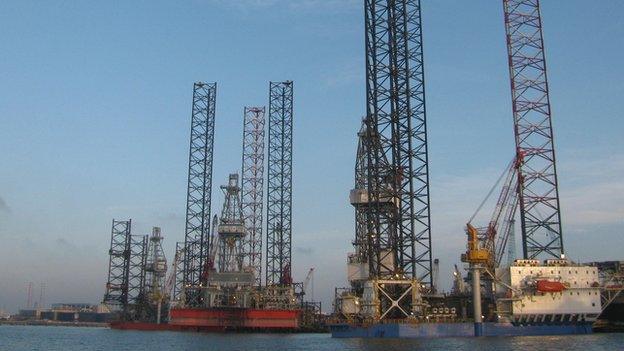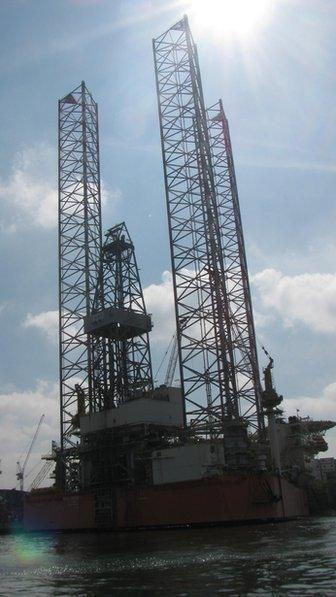Oil rigs fall idle after global crude prices drop
- Published
WATCH: Oil rigs across south east Asia are being mothballed
With the halving of world oil prices since June last year, the oil industry as a whole has been hit - but those involved in the manufacturing and servicing of offshore oil rigs have been especially affected.
Some industry analysts have said it is the worst market they've seen since 1985, as drilling programmes are postponed or cancelled, and oil rigs - together with their staff - are put out of commission.
The number of oil rigs actively drilling at any point in time, is considered a good gauge of the health of the industry.
Currently there are more than 180 oil rigs in South Asia alone, but with the downturn in oil prices more than half of those are now effectively without a role.
Worst still, there is an oil rig oversupply, with hundreds of old oil rigs still in the market, and newly-built ones waiting for work.
Too many rigs
Jack-up oil rigs, many of which are manufactured in Singapore, are used to drill for oil in relatively shallow waters.
There are more jack-up rigs in the worldwide offshore rig fleet than any other type.

Many surplus rigs are also parked in Malaysian waters, a less expensive option than Singapore, says David Griffin
Long-time oil industry specialist Ian Craven, with Icarus Consultants, says 91 new jack-up rigs were delivered to market between 2011 and 2014.
And he says while those rigs may have been absorbed into the market, up to now few old rigs have been scrapped to make room for them.
This, he explains, has led to a dog-eat-dog market place, with more rigs chasing fewer jobs and consequently losing work.
Many surplus jack-up and floater rigs end up in Singapore, Malaysia or Indonesia where they are put into idle mode - or what the industry refers to as 'stacked'.
Staff on board are replaced with skeleton teams, and the rigs are either kept ready for a new commission - or switched off before they are parked somewhere affordable, often off the shores of Malaysia or Indonesia.

The number of rigs currently drilling is often taken as a good gauge of the industry's health
"Hot stacking is when a rig is kept ready to go back to work, and most of these are in Malaysia with some in Singapore," says Mr Craven.
"Cold stacking is when they are mothballed and basically abandoned except for a watchman - and many of these end up in Labuan in Malaysia, or in Batam in Indonesia."
Knock-on effect
David Griffin is managing director of K2, a Singapore-based firm that specialises in oil rig inspection, repair and maintenance around the world.
He's been involved in the oil rig industry for more than two decades and says it has been at least 15 years since he's seen as many oil rigs decommissioned and stacked in the region.
There is a huge knock-on impact on the teams that support every oil rig being taken out of action, he says.
"You look at an individual rig, and you've got 120-180 people on board.

An out-of-commission jack-up oil rig parked in one of Singapore's shipyards
"Then you've got all the people that will be supporting that rig. There's the people back in the office, and all the supply related companies supporting that rig.
"So you might be able to stretch it out to 1,000 people that will be indirectly affected by one specific rig shutting down."
The oil industry is a cyclical one, so some question whether the last six months of falling oil prices and all the associated knock-on effects are simply part of new supply and demand cycle.
However, there was already an issue with an oversupply of rigs last year before the oil price started to drop last year, says Mr Griffin.
The oil price fall, coupled with old rigs still in service, and the large number of new rigs being built, has then compounded the problem.
"Other industries, like the aircraft industry and the shipping industry, are very quick to take out old and redundant assets to make way for the new ones," says Mr Griffin.
"But for some reason the oil industry has been very slow to do this.
"Oil companies are certainly reducing their demand for rigs, and they're using this as an opportunity to drive down their rates for existing contracts - and that's obviously having an effect on all the supply companies."
Not all bad news
But it is not all doom and gloom, he says, and a pick-up is on the horizon.
"The industry will be required to take a lot of the older rigs out of the market in order to put the supply and demand curve back at an appropriate level.
"Then, with a correction of oil prices, which will come in time, and a correction in the oil rig supply, which will come sooner, there will definitely be gradual improvement in the industry."
- Published19 January 2015
